The Big Bad Wolf in My House
 February 16th, 2021 by jules
February 16th, 2021 by jules

There are many things I like about following picture book imports, and one is that they often don’t shy from addressing some of life’s hardest challenges (even oftentimes exhibiting more of a willingness to let complex questions rest unanswered). Let’s look today at a picture book originally published in French about an extremely difficult topic — domestic abuse. Valérie Fontaine’s The Big Bad Wolf in My House (Groundwood Books), illustrated by Nathalie Dion, is a book that could be a lifeline for children experiencing this and a book that, at the very least, can help them feel seen. It was first published last year, will be on American shelves early next month, and has been translated by Shelley Tanaka.
The story bursts right out of the gate with little context — but it’s not needed. All we need to know is that “[h]e didn’t need to huff, or puff or blow the house down … The big bad wolf just walked in the door.” Illustrator Nathalie Dion portrays “him” as a steely-eyed wolf, standing on his back legs and carrying a rose to the woman who lives in the house he’s making a beeline for. On the floor inside the home, playing with Gilbert (her plush toy), is the woman’s daughter.
Fontaine expertly captures the kind of emotionally manipulative behavior displayed by an abusive partner: “He batted his eyelashes and purred like a pussycat in front of my mother,” the girl narrates. “But he looked at me with cold eyes and sharp teeth.” As the woman and the wolf embrace here, the girl stands in their shadow (both literally and metaphorically). One day, the wolf, “spitting mad,” yells at the girl’s mother for arriving home late, the girl quietly receding as a result; erratic, he throws his food on the floor when he deems it too cold; he “howls” at the girl’s mother; and he leaves “finger marks” on the girl’s arm. She covers up her bruises with long sleeves, even when suffering in hot weather because of it. As you can see below, the girl does her best to retreat from the sounds of “yelling and breaking,” but she can’t escape it.
There is an emotionally intensive two-page spread in which we see the wolf enter the girl’s room; she hides behind the door. At the page-turn, we read that she built a “fort … of bricks” around her heart. She does whatever she can to guard herself from his domineering presence and abuse. Eventually, the mother and girl leave — in a hurry. They stay in what appears to be a women’s shelter: “Mothers, children. But no wolves.” No ambiguity here. They get out. Thankfully.
Fontaine’s text includes moments of vivid figurative language — “The honeymoon was sour, like lemons” — but is largely straightforward, plainspoken. And she plays with the fairy tale structure of “The Three Little Pigs” with mentions of straw, wood, bricks, and more. (The abusive partners huffs and puffs, after all.) Dion gives the girl focus, though in one striking spread the wolf extends his back and howls loudly on the verso, the girl hiding behind her mother, whose body shields her, on the recto. Her palette is one of pale chartreuse shades, with the wolf standing out in a rich brown. The body language here says it all, the mother submissive in some spreads but standing tall when she hands the girl a suitcase and says, “We’re leaving. You have five minutes to find Gilbert.”
An intense — but important and utterly age-appropriate — look at something that will, sadly, speak to many children. (Note: The book closes with places to contact in both Canada and the US if a reader or someone they know needs help.) Here are some spreads. …
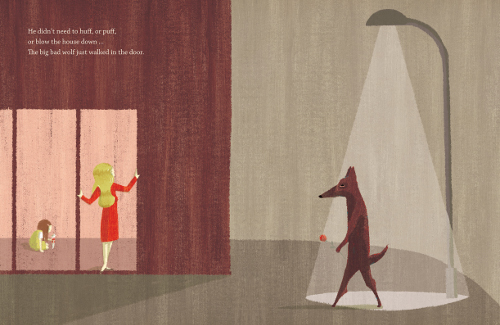
The big bad wolf just walked in the door.”
(Click spread to enlarge)
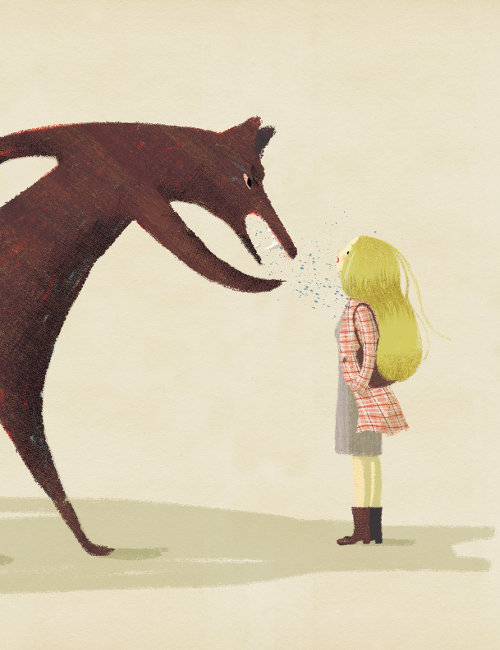
because I’m not allowed to say words like that.”
(Click spread to enlarge and see in its entirety)
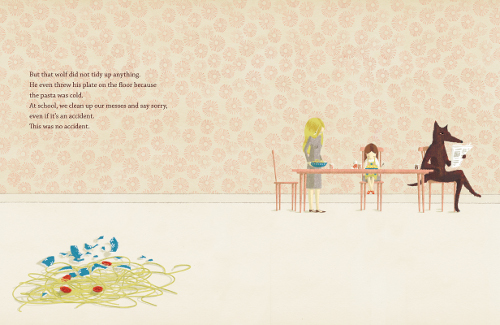
even if it’s an accident. This was no accident.”
(Click spread to enlarge)

But whenever the sounds of yelling and breaking started,
the blankets jumbled up around my head did not protect me
any more than a pile of straw.”
(Click spread to enlarge)
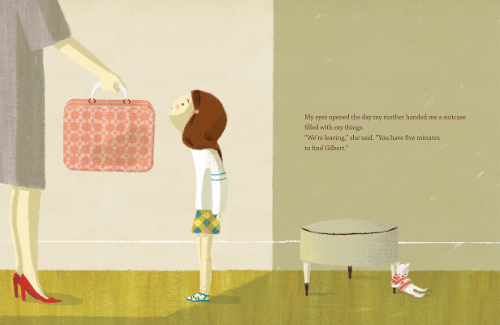
‘We’re leaving,’ she said. ‘You have five minutes to find Gilbert.'”
(Click spread to enlarge)
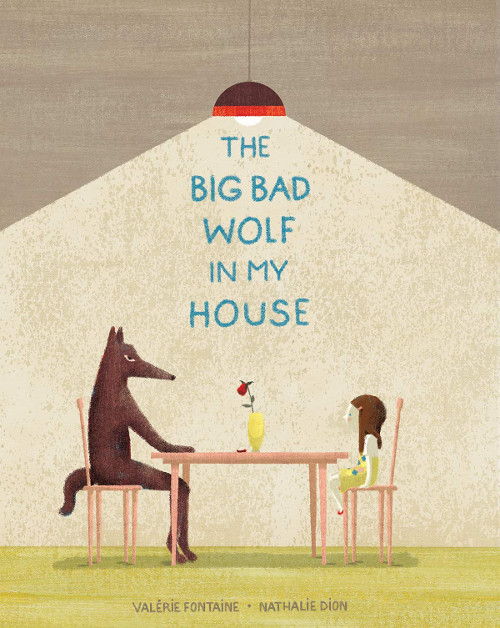
THE BIG BAD WOLF IN MY HOUSE. First published in French in 2020 by les Éditions Les 400 coups. Original title: Le grand méchant loup dans ma maison. © 2020 Valérie Fontaine, Nathalie Dion et les Éditions Les 400 coups, Montréal (Québec) Canada. Published in English in Canada and the USA in 2021 by Groundwood Books. English translation copyright © 2020 by Groundwood Books. Illustrations reproduced by permission of Groundwood Books.

I noticed this post didn’t have any comments, and I just wanted to say thank you for sharing this powerful picture book. I hope it finds the children who need it.
Me too, Christi. Thanks!
I love bob the minion, I love all minions! If I was a minion….. heh….. my house would be made evilly to stop that dreaded wolf! Minion Bob OUT!